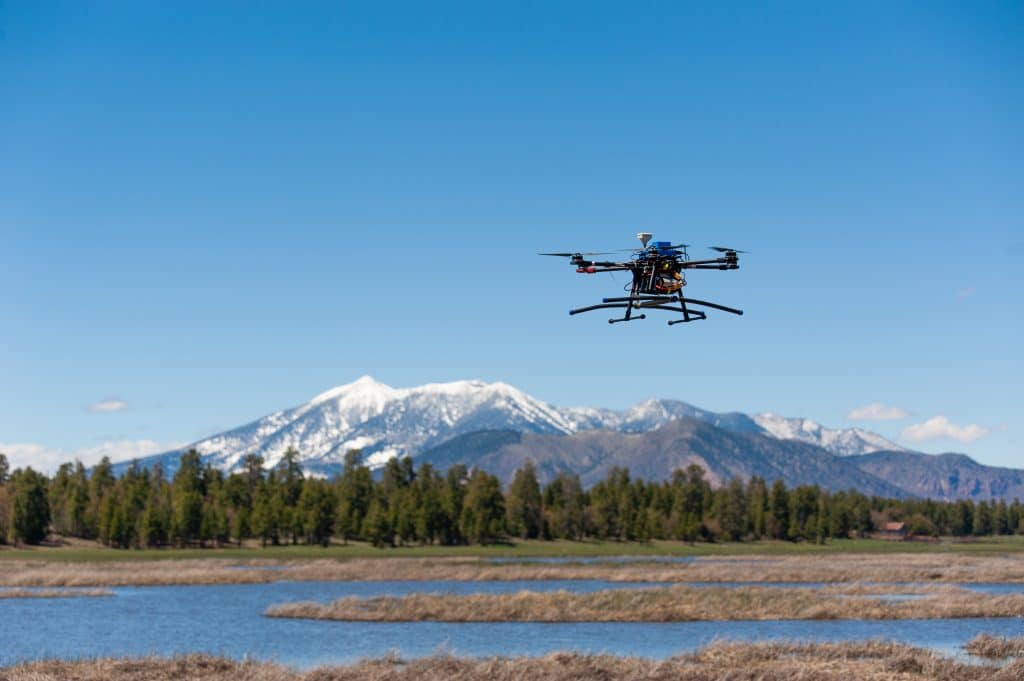Oct. 1, 2019
Biologists and ecologists monitor wildlife to learn more about their behaviors, but tracking small creatures can be challenging, time-consuming and costly. Through a National Science Foundation grant, a multidisciplinary team at Northern Arizona University—led by Michael Shafer, associate professor of mechanical engineering; Carol Chambers, professor of wildlife ecology; and Paul Flikkema, professor of electrical engineering—has developed technology that could revolutionize the way this research is conducted through the use of unmanned aerial vehicles (UAVs). Better yet, the scientists are sharing what they have learned in a paper appearing in Methods of Ecology and Evolution, a peer-reviewed journal published by the British Ecological Society.
“We want to help people who study wildlife better track small animals that have been tagged with tiny tracking devices, and we want other labs to take what we’ve learned and improve on it so that biologists have cost-effective tools that best suit their needs,” Shafer said.
Rising above the ground noise
For more than 50 years, scientists studying small birds and animals—such as bats, mice and lizards—have used a tried-and-true tagging technology that uses very high frequency (VHF) radio beacons to track them. These tags are lightweight, affordable and easy to deploy in the field. Nevertheless, the data collected has been sparse because detecting the transmissions and determining exactly where the signals are coming from are arduous tasks.
After tagging and releasing an animal, a field tracker might spend hours or even days combing an area for transmissions by using a hand-held or pole-mounted antenna to pick up signals, attempting to triangulate the subject’s location. Time is the enemy in this research. The tag can come loose or be damaged, and even if it remains stable and secure, the battery eventually dies. That means finding and recording the transmissions within a short period is vital. Using UAVs to elevate antennas is one way to make tracking more manageable.
“The fundamental idea was to get off the ground,” Shafer said. “Wildlife scientists have told me that if they had a 400-foot pole to mount an antenna on, locating the transmissions would be easier. The higher the antenna is from the ground, the better it can pick up distant transmissions because there isn’t as much ground interference between the antenna and the tag.”
Students design first-generation prototype device
Mechanical engineering students in Shafer’s Dynamic and Active Systems Lab designed the first-generation prototype UAV-mounted antenna to help scientists home in on transmissions. Unlike a pole, the drone is far more agile because it can spin and travel up to 1.5 kilometers.
“We know that once the antenna is in the air, it can hear the tags’ transmissions much farther away than a tracker on the ground can,” Shafer said. “Think of it as a radio vacuum cleaner. As it gains altitude, it sucks up all the radio data. For example, we could have it fly a kilometer transect off the road, and when it comes back, we can replay that audio to see whether we hear the tag.”
At this point, detecting the signal is entirely manual. Trackers still use headphones and hand-held devices to pick up the signal, but now they can send a UAV to find out approximately where the signal is coming from. In future iterations of the device, Shafer plans to improve signal detection capabilities.
“We want to make improvements to our detection algorithms to make that process easier. That’s something we will pursue in the near future,” he said.
The vehicle is fairly large (about 40 inches across and 14 inches tall) because Shafer said he asked his students to overdesign the first-generation system.
“I told them to overbuild it so that we could pick and choose the parts we want without worrying about payload. Most drones aren’t designed to carry much weight, so if a payload is added, there’s a real drop in flight time. We also built it with redundancies so if one motor fails, the vehicle won’t fall out of the sky.”
Providing the know-how to a broad community
As part of the NSF grant requirements, Shafer and his team are sharing how they created the device and what they have learned. In the published paper, Shafer, Flikkema and graduate students Gabriel Vega and Kellan Rothfus provide instructions and a list of the exact materials they used, such as the model of motors, the software they developed and all the other hardware specifications. The team also shared the information on a new website.
By sharing exactly how they constructed their device, Shafer and his team hope that other labs and life scientists will adapt the technology to meet a suite of research needs.
“If scientists are looking for a really small animal on the ground, the antenna can be configured straight down, but if they are looking for a songbird in a tree, obviously, the antenna should scan outward,” Shafer said. “There’s a learning curve, and the users will need to use what they know about animal behavior as they configure the device to work best for them. They will need to experiment with it.”
Shafer joined the faculty of NAU’S Department of Mechanical Engineering in 2013. His research interests include unmanned aerial robotic systems, advanced actuation technologies, small scale energy harvesting and bio-inspired engineering systems.
Photo credit: Jose Gabriel Martinez-Fonseca and NAU’s Dynamic and Active Systems Lab

Kerry Bennett and Amy K. Phillips
Office of the Vice President for Research



